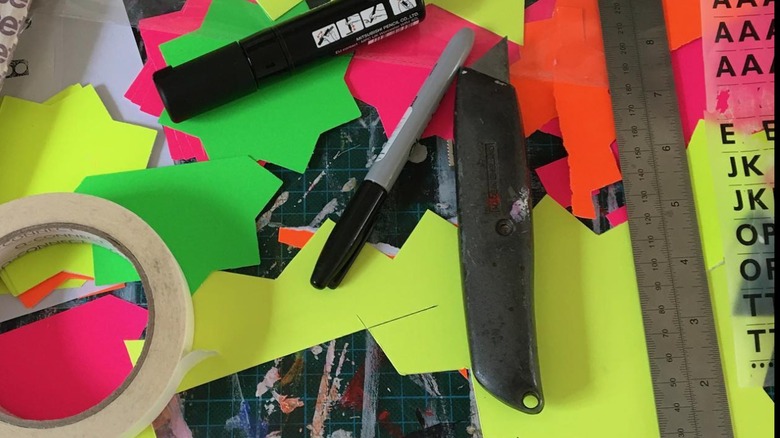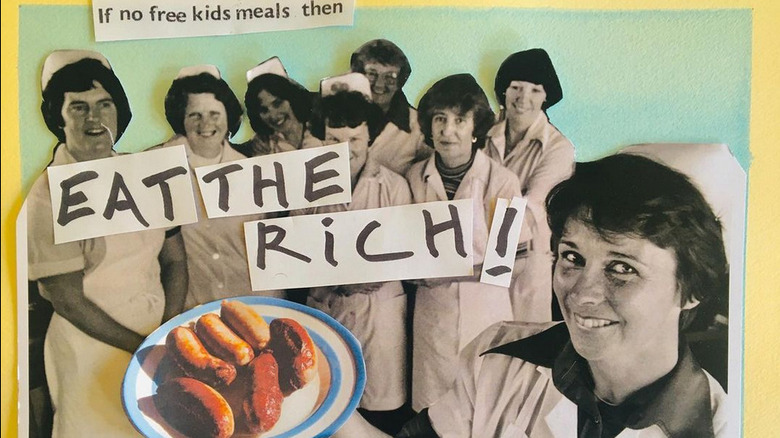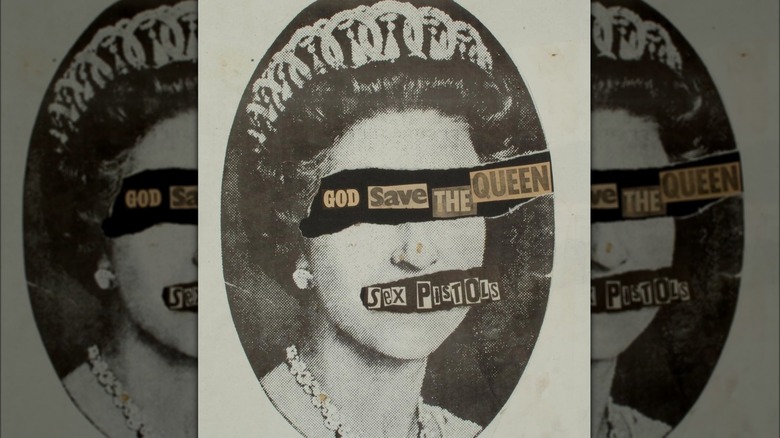How Jamie Reid's Art Came To Define The British Punk Rock Scene
Few bands have had such an instant and explosive impact on the world of popular music as the Sex Pistols. All it took was about two years of buzz generated from live shows, and a few hit singles like "Anarchy in the U.K.," for their first 1977 album "Never Mind the Bollocks, Here Comes the Sex Pistols" to leave a permanent impact on punk and rock. The Clash, The Smiths, Joy Division, Social Distortion, Nirvana, Guns N' Roses, Green Day, and many more cite the Sex Pistols as a pioneering influence, per Alternative Press. All those bands embrace punk's riotous, rebellious, and brazen ethos to varying degrees, and in different ways. But the '70s "punk" movement was far more than musical. It was political, aesthetic, and artistic all rolled into one.
When thinking of punk's visuals, folks might first think of fashion: leather jackets, spiked hair, chains, and so forth, donned by strung out-looking dudes who can barely play their instruments while wailing through garbled, trashy mixes. The words "punk art" might evoke chaotic imagery, or scenes of gnashing teeth and middle fingers driven towards monarchs. The Sex Pistol's "décollage" album covers not only depict and embody this style, but originated it. We're talking serial killer-note-like block letters, defaced photographs, and pell-mell slashes of explosive color and pattern combinations, like on Artnet. That style comes from one person and one person only: artist Jamie Reid, whose visual design helped define punk and bundle it into a bonafide cultural movement.
Artistic defiance and iconoclasm
In comparison to some of Reid's later works, like 1993's "Damn Them All" featuring disfigured and torn images of British royalty (seen on Retroavangarda), Jamie Reid's early, pink-and-yellow album cover work for the Sex Pistol's 1977 "Never Mind the Bollocks, Here Comes the Sex Pistols" comes as simple. But it was just enough, at just the right time, to capture the '70s punk spirit. Reid's design is ragged, off-the-cuff, and doesn't care what you think — just like punk and its musicians. It's also utterly iconoclastic. The poster for the Sex Pistol's single "Anarchy in the U.K." featured a ripped Union Jack flag, while alternative covers for "God Save the Queen" featured Elizabeth II with swastikas for eyes and a safety pin through her lip. Such sentiments align perfectly with punk.
Iconoclasm and defiance were Reid's intentions from the get-go. As The Guardian quotes him: "Our culture is geared towards enslavement — for people to perform pre-ordained functions, particularly in the workplace. I've always tried to encourage people to think about that and to do something about it." On the heels of the 1960s anti-establishment shift, Reid found a home at the "countercultural publication" Suburban Press in the '70s, where he refined his singular "cut-and-paste" and "ransom note" style. As luck would have it, he'd already met the Sex Pistol's future manager Malcolm McLaren back in Croydon Art School. So when the Sex Pistols needed some artwork for their records, Reid was the man to call.
Countercultural artist turned revered creator
In the 1987 book "Up They Rise: The Incomplete Works of Jamie Reid" by "punk historian" Jon Savage, Savage credits Jamie Reid's very real political ideology with pushing Reid ahead of his punk peers, per The Guardian. He said that Reed's work "came from a deep place" that gave it "an added element of sophistication" when compared with "some of the rather tawdry and imitative punk graphics" of other artists.
And indeed, history nowadays — particularly English history — looks back fondly on its wayward, monarch-flouting child. Reid's work has been on display in the Tate Britain in London, as well as the Museum of Modern Art (MOMA) in New York City, and more.
Sites like Enter Gallery list limited-edition Reed prints for sale, many of which are sold out at the time of writing. Punk Flyer has many more on sale, most of which are signed and numbered, including original Sex Pistols memorabilia that the reader will recognize as drafted in Reed's style. None of these items have any price listed. In 2016, however, Inside Croydon described one of Reed's works going on sale for 1 million pounds at a London shop. It might seem bizarre for the work of an anti-establishment, countercultural artist to transform into a blisteringly ironic high-end objet d'art for the wealthy, but maybe that's part of punk's message, too: keep resisting and keep yourself scrappy, or else you run the risk of mutating into the powers that be.


